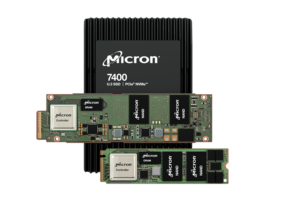
Micron Ships New Data Center SSDs, Teases DDR5

Micron today launched its 7400 series solid state drives (SSDs), a new family of fourth-generation PCIe-based NVMe devices that should give data center operators more storage bang for their buck. The company also talked up development of its DDR5 memory technology which is still in development.
The 7400 family of SSDs are based on Micron’s 96-layer 3D TLC NAND technology, which is compatible with NMVe version 1.4. Micron is shipping seven different form-factors, including two small M.2 cards for tablets and ultrabooks, three U.3 configurations for server-mounted drives, and two configurations for the rack-mountable E1.S. Depending on the form factor and configuration, Micron 7400 drives feature storage capacities of 400GB to 7.68TB per drive.
According to Micron, the 7400 delivers twice the throughput of third-gen NVMe drives for the same amount of energy. They’re also compatible with those PCIe Gen 3 drives, simplifying the upgrade path from Gen3 to Gen 4.
Each drive supports up to 128 namespaces, enabling customer to use them with a wide variety of SQL, NoSQL, block storage, object storage, and software-defined storage implementation. They also support the Open Compute Project (OCP) standard, which should help improve compatibility and interchangeability with other SSD drive makers that support OCP.
In a press briefing earlier today on the Internet, Jeremy Werner, the corporate vice president and general manager of Micron’s Storage Business Unit, said the company was excited to deliver a “fully vertically product” that includes Micron-developed technology top to bottom.
“The amazing thing about this product is it’s bringing so much flexibility to our customers,” Werner said. “It actually has the world’s broadest portfolio of form factors, which is really critical because we are at this nexus right now in the data center where there is a lot of legacy systems and now we’re moving to more flash-optimized systems.”
While there is a lot of spinning disk in data centers at the moment, the hottest workloads are moving to flash, he said.
“In the past of course hard drives were huge for data centers, and they continue to be used heavily for colder data,” Werner said. “But as flash has become more affordable, a lot of the hard drive applications have moved to flash and now really most of the compute and the high performance applications rely on flash in the data center.”
With three different EDSFF, or data center, form factors, the Micron 7400 family will help data center operators expand their use of flash storage while boosting performance, reducing footprint, and reducing energy consumption, Werner said.
“In fact, these products deliver almost a million IOPS in just in just six watts, which is over double the amount of performance per watt that we had in our Gen3 generation of NVMe SSDs,” he said.
The new drives also support TCG-Opal 2.01 and IEEE-1667, which are new standards for protecting data while it’s in-flight and at-rest. The company also touted the development of its Secure Execution Environment (SEE) technology, which it says will help to isolate transactions.
Micron also provided an update on the next-generation of its DRAM technology during the press briefing. According to Raj Hazra, senior vice president and GM of the Compute and Networking Business Unit at Micron, DDR5 will deliver a significant boost in sage bandwidth compared to DDR4 (up to 85%, according to a January 2020 press release).
“DDR5 is a gamechanger in terms of direct-attached memory for the data center,” Hazra said. “We see tremendous pent up demand for the capabilities of DDR5, particularly as a sign of how critical memory is in unlocking that promise of the future of the data center. And that transformation really starts with the first DDR generation of products built specifically for the data center in mind, and that’s DDR5.”
Related Items:
Micron Bridges Memory Bandwidth Gap for ML
Micron Stacks Higher to Boost 3D NAND Flash
Micron Delivers 3D XPoint Drive, Acquires FPGA Device Maker



























